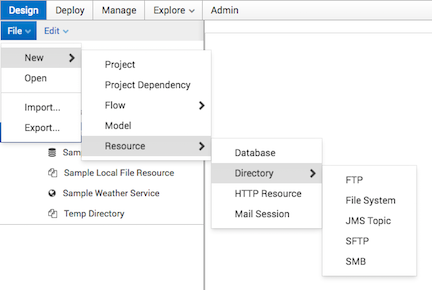-
Notifications
You must be signed in to change notification settings - Fork 83
resources
Resources represent connections to physical end-points where data is read from or written to. A resource is configurable per environment (agent). This allows a flow to be tested against a resource configured for testing and then deployed to an agent with resources configured for production.
The following resource types are available in Metl:
| Rsource Type | Description |
|---|---|
Database |
|
A JDBC connection to a JDBC compliant relational database |
|
Directory |
|
A connection to a local file system |
|
An FTP connection to a file system |
|
An SFTP connection to a file system |
|
An SMB connection to a server |
|
A JMS connection to a specified queue and topic |
|
HTTP(S) |
|
An HTTP(S) connection to REST or SOAP based services |
|
Mail Session |
|
An SMTP connection to a Mail server |
|
Subscribe |
|
A JMS connection to a specified queue or topic that can be subscribed to |
|
Queue |
|
A Kafka Publisher |
|
An Amazon simple queue service |
|
Cloud Bucket |
|
Amazon Simple Storage Service |
|
Resources are defined on a project by project basis. In order to create a new resource, Click on the "Resources" folder in the Navigation pane, click the "New" menu item, and then select the type of resource to be created.

If resources will be shared across multiple projects, a project can be defined that only contains resources, and then that project can be used as a Project Dependency for other projects that will leverage the shared resources.
When a flow is deployed, its associated resources are automatically deployed with it. A flow, and thus its associated resources, can be deployed to one or more Metl agents. Each deployment of that resource on a given agent can have different settings. For example, companies typically have several environments for a given system (i.e. development, test, user acceptance test, production). A flow and its resources can be deployed to the development agent/environment with settings specific to the development environment (i.e. server names, ids, passwords, etc.) When that same flow is deployed to the test agent/environment the resources on the test environment can be changed for the specifics of that environment. The flow itself stays the same regardless of the environment in which it is running. This allows seamless migrations from environment to environment.
To edit the settings of a resource, double click the resource in the navigation pane, and the settings details will be displayed in the content pane.
To find all flows and components that reference a resource, highlight the desired resource, then select File Where Used. This will display a screen showing all project - flow - components that reference the highlighted resource. Selecting a row and clicking the 'Open Flow' button will open the flow in a new tab.